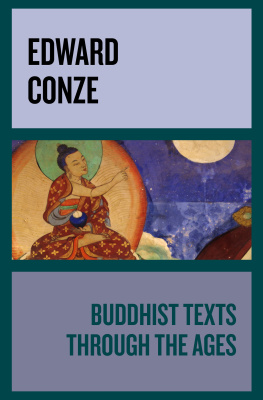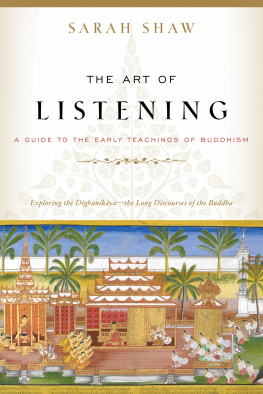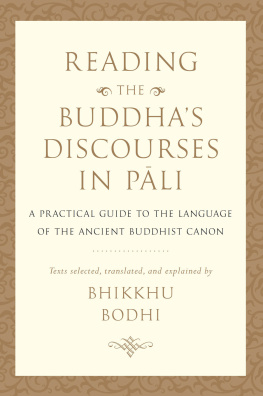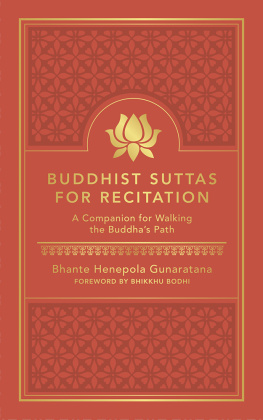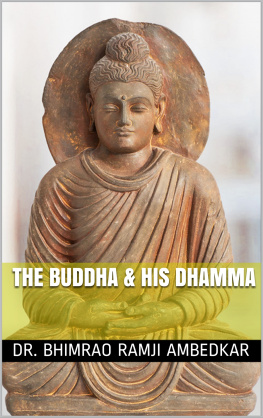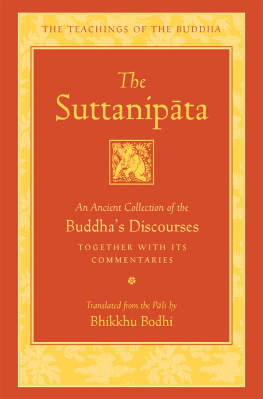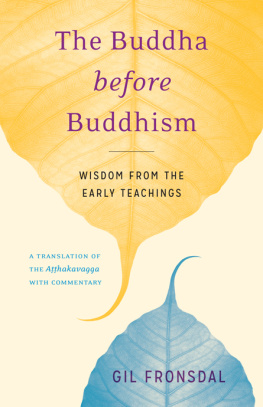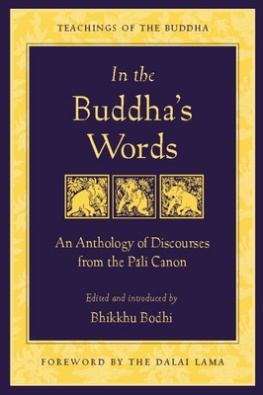WHAT THE BUDDHA TAUGHT

Bhaisajya-guru. The Buddha as the Great Doctor for the Ills of the Worldfrom Japan
What the Buddha Taught
(Revised edition)
WALPOLA SRI RAHULA
Tripitakavgivarchrya

With a Foreword by
PAUL DEMIVILLE
and
a collection of illustrative texts translated from the original Pali

Also by Walpola Sri Rahula
History of Buddhism in Ceylon
The Heritage of the Bhikkhu
Copyright 1959 by W. Rahula
Second and enlarged edition copyright 1974 by W. Rahula
All rights reserved. No part of this book may be reproduced in any form or by any electronic or mechanical means, or the facilitation thereof, including information storage and retrieval systems, without permission in writing from the publisher, except by a reviewer, who may quote brief passages in a review. Any members of educational institutions wishing to photocopy part or all of the work for classroom use, or publishers who would like to obtain permission to include the work in an anthology, should send their inquiries to Grove/Atlantic, Inc., 841 Broadway, New York, NY 10003.
Published simultaneously in Canada
Printed in the United States of America
Library of Congress Catalog Card Number: 73-21017
ISBN-10: 0-8021-3031-3
ISBN-13: 978-0-8021-3031-0
Grove Press
an imprint of Grove/Atlantic, Inc.
841 Broadway
New York, NY 10003
Distributed by Publishers Group West
www.groveatlantic.com
06 07 08 09 10 11 45 44 43 42 41
Contents
Man is supremeOne is ones refugeResponsibilityDoubtFreedom of ThoughtToleranceIs Buddhism Religion or Philosophy?Truth has no labelNo blind faith or belief, but seeing and understandingNo attachment even to TruthParable of the raftImaginary speculations uselessPractical attitudeParable of the wounded man
THE FOUR-NOBLE TRUTHS
CHAPTER II
Buddhism neither pessimistic nor optimistic, but realisticMeaning of DukkhaThree aspects of experienceThree aspects of DukkhaWhat is a being?Five AggregatesNo spirit opposed to matterFluxThinker and ThoughtHas life a beginning?
DefinitionFour NutrimentsRoot cause of suffering and continuityNature of arising and cessationKarma and RebirthWhat is death?What is rebirth?
What is Nirva?Language and Absolute TruthDefinitions of NirvaNirva not negativeNirva as Absolute TruthWhat is Absolute Truth?Truth is not negativeNirva and SasraNirva not a resultWhat is there after Nirva?Incorrect expressionsWhat happens to an Arahant after death?If no Self, who realizes Nirva?Nirva in this life
Middle Path or Noble Eightfold PathCompassion and WisdomEthical ConductMental DisciplineWisdomTwo sorts of UnderstandingFour Functions regarding the Four Noble Truths
What is Soul or Self?God and Soul: Self-protection and Self-preservationTeaching Against the CurrentAnalytical and Synthetical methodsConditioned GenesisQuestion of Free-willTwo kinds of TruthsSome erroneous viewsThe Buddha definitely denies AtmanThe Buddhas silenceThe idea of Self a vague impressionCorrect attitudeIf no Self, who gets the result of Karma?Doctrine of Anatta not negative
Erroneous viewsMeditation is no escape from lifeTwo forms of MeditationThe Setting-up of MindfulnessMeditation on breathingMindfulness of activitiesLiving in the present momentMeditation on Sensationson Mindon Ethical, Spiritual and Intellectual subjects
Erroneous viewsBuddhism for allIn daily lifeFamily and social lifeLay life held in high esteemHow to become a BuddhistSocial and economic problemsPoverty: cause of crimeMaterial and spiritual progressFour kinds of happiness for laymenOn politics, war and peaceNon-violenceThe ten duties of a rulerThe Buddhas MessageIs it practical?Asokas ExampleThe Aim of Buddhism
Illustrations
FRONTISPIECE
The Buddha as Bhaisajya-guru or Bhisakka in Pali texts (A. Colombo, Ed. p. 822), the Great Doctor for the Ills of the World. He holds the casket of medicine in his left hand, raising his right hand in Abhaya-mudr, the symbol of safety and peace. Yakushi Nyorai. Wood. 9th century A.C. Gango-Ji Temple, Japan. Photo: Bulloz, Paris.
BETWEEN PAGES 16 AND 17
I. The bust of the Buddha. Bronze. Thailand. Sukhotai. About 14th century A.C. Muse Guimet, Paris. By courtesy of the Muse Guimet, Paris.
II. The head of the colossal stone statue of the recumbent Buddha. Galvihra, Polonnaruva, Ceylon. 12th century A.C. By courtesy of Mrs. Mona de Mel.
BETWEEN PAGES 32 AND 33
III. The interior of one of the cave temples at Dambulla, Ceylon. 1st century B.C. The statues and paintings seen in the illustration are of later date. By courtesy of the Muse Guimet, Paris.
IV. The Great Renunciation. Prince Siddhrtha leaving his wife and child and palace to become an ascetic in search of Truth. Ananda Temple, Pagan, Burma, 11th to 12th century A.C. By courtesy of the Muse Guimet, Paris.
V. The Buddha. Mathura, India. 5th Century A.C. Mathura Museum. By courtesy of the Muse Guimet, Paris.
VI. The Buddha. Yun Kang style. China. End of the 5th century A.C. Muse Guimet, Paris. By courtesy of the Muse Guimet, Paris.
BETWEEN PAGES 48 AND 49
VII. The Buddha showing the myrobalan fruit (or gem?) on his right palm. Here is represented the significance of the expression ehi-passika come and see, which is used to describe his teachingsee p. 9. Bronze from Tibet. Muse Guimet, Paris. By courtesy of the Muse Guimet, Paris.
VIII. Head of the Buddha. Hadda, Afghanistan. Stucco. Graeco-Indian style, 3rd to 4th century A.C. Muse Guimet, Paris. By courtesy of the Muse Guimet, Paris.
IX. The Buddha. Prah Khan, Cambodia. Khmer Art, Bayon style. 12th century A.C. Muse Guimet, Paris. By courtesy of the Muse Guimet, Paris.
X. Sasra-cakra or Bhava-cakra, the Cycle of Existence and Continuity. Tibet. Museum fr Vlkerkunde, Hamburg. By courtesy of the Muse Guimet, Paris.
BETWEEN PAGES 64 AND 65
XI. Sujt offering milk-rice to the Buddha on the day of his Enlightenment. Borobudur, Java. 8th century A.C. By courtesy of the Muse Guimet, Paris.
XII. Head of the Buddha. Borobudur, Java. 8th century A.C. Museum, Leiden. By courtesy of the Muse Guimet, Paris.
XIII. The Buddha in Dharmacakra-mudr, symbolizing preaching. Borobudur, Java. 8th century A.C. By courtesy of the Muse Guimet, Paris.
XIV. The Parinirva of the Buddha. Ajanta, India. Cave 26. 6th century A.C. By courtesy of the Muse Guimet, Paris.
BETWEEN PAGES 80 AND 81
XV. The Buddha in Dharmacakra-mudr, symbolizing preaching. Sarnath, India. 5th century A.C. By courtesy of the Muse Guimet, Paris.
XVI. The Buddha. Borobudur, Java. 8th century A.C. By courtesy of the Muse Guimet, Paris.
Foreword
by Paul Demiville
Member of the Institut de France,
Professor at the College de France
Director of Buddhist Studies at the School
of Higher Studies (Paris)
Here is an exposition of Buddhism conceived in a resolutely modern spirit by one of the most qualified and enlightened representatives of that religion. The Rev. Dr. W. Rahula received the traditional training and education of a Buddhist monk in Ceylon, and held eminent positions in one of the leading monastic institutes (Pirivena) in that island, where the Law of the Buddha flourishes from the time of Asoka and has preserved all its vitality up to this day. Thus brought up in an ancient tradition, he decided, at this time when all traditions are called in question, to face the spirit and the methods of international scientific learning. He entered the Ceylon University, obtained the B.A. Honours degree (London), and then won the degree of Doctor of Philosophy of the Ceylon University on a highly learned thesis on the History of Buddhism in Ceylon. Having worked with distinguished professors at the University of Calcutta and come in contact with adepts of Mahyna (the Great Vehicle), that form of Buddhism which reigns from Tibet to the Far East, he decided to go into the Tibetan and Chinese texts in order to widen his cumenism, and he has honoured us by coming to the University of Paris (Sorbonne) to prepare a study of Asanga, the illustrious philosopher of Mahyna, whose principal works in the original Sanskrit are lost, and can only be read in their Tibetan and Chinese translations. It is now eight years since Dr. Rahula is among us, wearing the yellow robe, breathing the air of the Occident, searching perhaps in our old troubled mirror a universalized reflection of the religion which is his.
Next page

